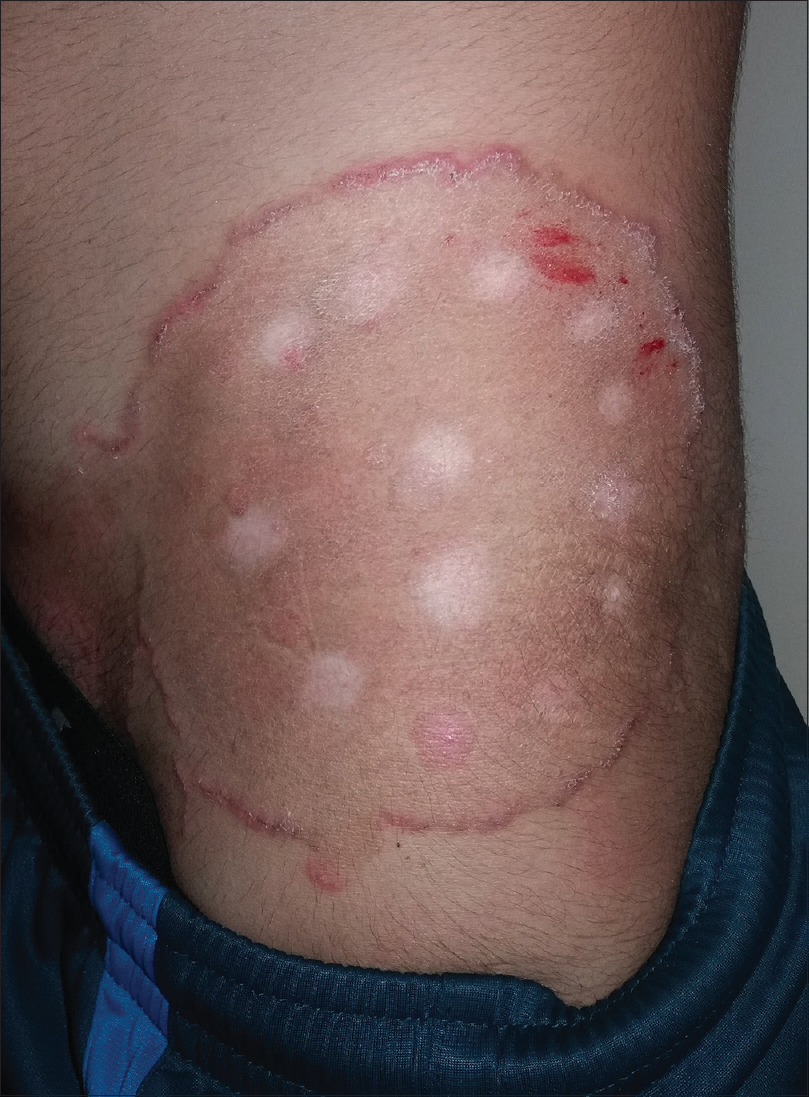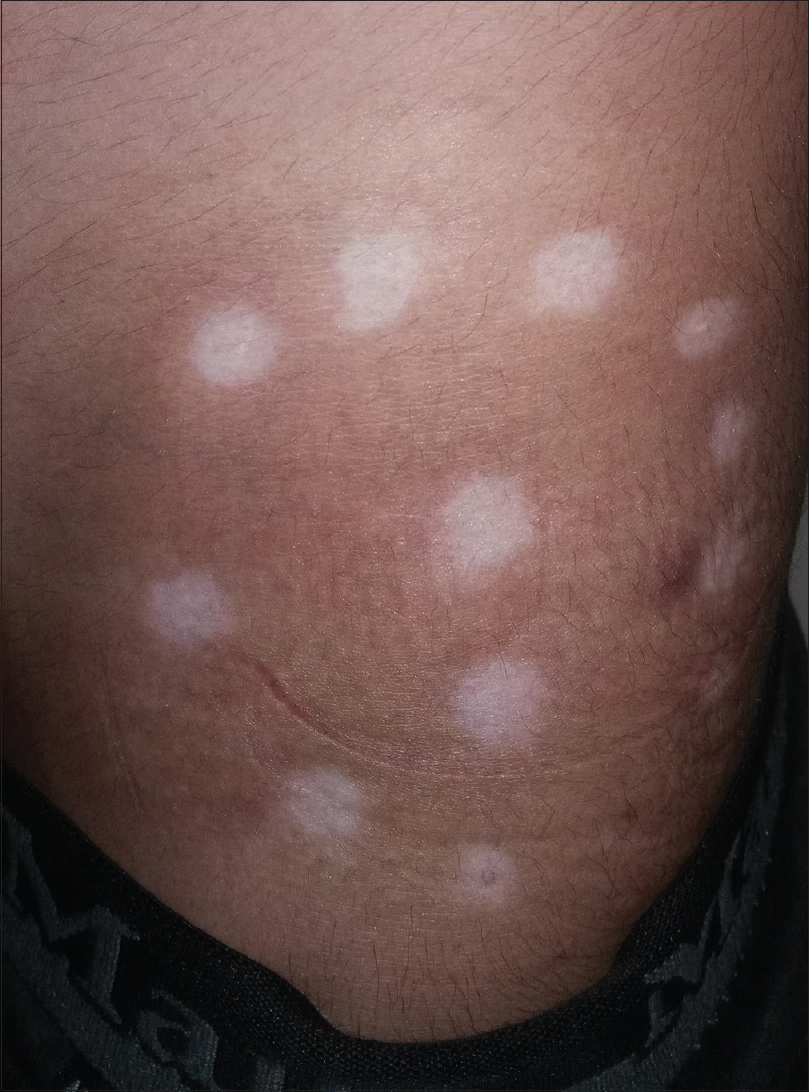Translate this page into:
Intralesional steroids in dermatophytosis: Quackery in India takes new route
Correspondence Address:
Sakshi Agrawal
Department of Dermatology and Venereology, Institute for Medical Sciences and Research Centre, Jaipur National University, Jaipur, Rajasthan
India
| How to cite this article: Srivastava A, Agrawal S. Intralesional steroids in dermatophytosis: Quackery in India takes new route. Indian J Dermatol Venereol Leprol 2019;85:568 |
Sir,
Erroneous management of skin diseases using corticosteroids is rampant in India. It includes misuse of both topical and systemic corticosteroids. Right now, as dermatologists, we are focusing on eliminating the misuse of topical corticosteroids.[1],[2] Unfortunately, quacks in India have now started using intralesional corticosteroids too, thus moving one step ahead.
A 16-year-old man (Case 1) presented to our dermatology outpatient department with complaints of itchy, red, rounded skin lesions for the past 8 months which started from groin, gradually involving the adjacent areas of abdomen and thighs. He then visited a local practitioner (unqualified) who injected triamcinolone acetonide 40 mg/ml directly into the skin lesions. The procedure was repeated at weekly intervals for three sessions. Patient reported some relief in itching but later noticed loss of pigmentation over the affected areas and presented to our department. On examination, we detected multiple annular plaques with well-defined erythematous margins and superficial fine white scaling over abdomen and thighs. Also, multiple hypopigmented areas were present at the injection sites [Figure - 1]. Similar presentation was noted in another patient (Case 2) who received weekly injections for four sittings and presented with loss of pigmentation at the site of intralesional steroid injection. Although no prescription was available, both patients showed us the culprit drug. Both of them were started on oral itraconazole 100 mg twice daily and topical ketoconazole cream and obtained favourable responded within 2 weeks. We continued therapy for 1 month further to counter the long duration of disease and improper treatment with topical and intralesional corticosteroids. Fortunately, no relapse was noted after 1 month of stopping therapy. However, no improvement in hypopigmentation was noticed [Figure - 2].
 |
| Figure 1: Well-defined plaque of tinea with areas of hypopigmentation (Case 1) |
 |
| Figure 2: Clearance of plaque after antifungal therapy but with persistent hypopigmentation (Case 1) |
Quackery is common in India, particularly in rural areas. Many self-proclaimed “doctors” do not even have the requisite professional qualifications. It is shocking to know that almost one-third (31.4%) of those “allopathic doctors” received education barely upto secondary school level, while a staggering 362,478 (57.3%) of these so-called doctors lack a medical qualification.[3] Lack of medical qualification is much more common in rural areas.[3]
Current population of India is more than 1.3 billion, while we have barely 10,000 qualified dermatologists.[4] Therefore, majority of our population seeks primary dermatologic care from general practitioners who have an inadequate knowledge of dermatology. Many of these practitioners practice alternative medicine systems and many have no valid medical qualification.[5]
Another unfortunate point is that even qualified allopathic general practitioners are inadequately trained in dermatology. This leads to erroneous diagnoses and treatments, economic loss to patients, as well as adverse drug reactions, even if the patient has reached to a qualified doctor on time.[5]
In the present cases, the health care provider might have observed from some qualified dermatologist using intralesional corticosteroids and have extrapolated it for any skin disorder blindly. At present, it is nearly impossible to curb such quacks. It has been estimated that 1 in 20 people have a skin disease in India.[6] Therefore, we probably need to modify the MBBS curriculum, giving adequate weightage to dermatology. The undergraduate medical students should be trained well in dermatology so that they are able to correctly diagnose and treat at least the most commonly encountered diseases such as tinea and scabies.[7] Timely referral to the concerned specialist is also needed. It has been noted that general practitioners usually prescribe a cocktail consisting of antihistamines, oral steroid, antifungal, antimicrobial and deworming agent, along with a topical steroid–antifungal–antimicrobial combination for blanket treatment of all dermatologic problems.[7] Therefore, we strongly feel that our association must now focus on reforming medical education in India so that future “qualified” practitioners of India do not become “quacks” in dermatology.
Declaration of patient consent
The authors certify that they have obtained all appropriate patient consent forms. In the form, the patients have given their consent for their images and other clinical information to be reported in the journal. The patients understand that name and initials will not be published and due efforts will be made to conceal identity, but anonymity cannot be guaranteed.
Financial support and sponsorship
Nil.
Conflicts of interest
There are no conflicts of interest.
| 1. |
Coondoo A. Topical corticosteroid misuse: The Indian scenario. Indian J Dermatol 2014;59:451-5.
[Google Scholar]
|
| 2. |
Pande S. Steroid containing fixed drug combinations banned by Government of India: A big step towards dermatologic drug safety. Indian J Drugs Dermatol 2016;2:1-2.
[Google Scholar]
|
| 3. |
Anand S, Fan V. The Health Workforce in India – World Health Organization: Human Resources for Health Observer – Issue No. 16. Available from: http://www.who.int/hrh/resources/hwindia_health-obs16/en/. [Last accessed on 2017 Sep 02].
[Google Scholar]
|
| 4. |
Available from: http://www.iadvl.com/index.php. [Last accessed on 2017 Dec 16].
[Google Scholar]
|
| 5. |
Verma S. Nonclinical challenges of Indian dermatology – cities vs. villages, poverty, and lack of awareness. Int J Dermatol 2007;46 Suppl 2:42-5.
[Google Scholar]
|
| 6. |
Thappa DM. History of dermatology, venereology and leprology in India. J Postgrad Med 2002;48:160-5.
[Google Scholar]
|
| 7. |
Kaur P, Singh G. Community dermatology in India. Int J Dermatol 1995;34:322.
[Google Scholar]
|
Fulltext Views
3,107
PDF downloads
2,139





